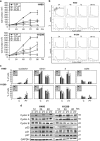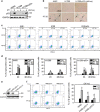P53-dependent downregulation of hTERT protein expression and telomerase activity induces senescence in lung cancer cells as a result of pterostilbene treatment
- PMID: 28796247
- PMCID: PMC5596539
- DOI: 10.1038/cddis.2017.333
P53-dependent downregulation of hTERT protein expression and telomerase activity induces senescence in lung cancer cells as a result of pterostilbene treatment
Abstract
Cellular senescence is characterized by permanent cell cycle arrest, triggered by a variety of stresses, such as telomerase inhibition, and it is recognized as a tumor-suppressor mechanism. In recent years, telomerase has become an important therapeutic target in several cancers; inhibition of telomerase can induce senescence via the DNA damage response (DDR). Pterostilbene (PT), a dimethyl ether analog of resveratrol, possesses a variety of biological functions, including anticancer effects; however, the molecular mechanisms underlying these effects are not fully understood. In this study, we investigated the possible mechanisms of PT-induced senescence through telomerase inhibition in human non-small cell lung cancer cells and delineated the role of p53 in senescence. The results indicated that PT-induced senescence is characterized by a flattened morphology, positive staining for senescence-associated-β galactosidase activity, and the formation of senescence-associated heterochromatic foci. Telomerase activity and protein expression was significantly decreased in H460 (p53 wild type) cells compared with H1299 (p53 null) cells and p53 knockdown H460 cells (H460-p53-). A more detailed mechanistic study revealed that PT-induced senescence partially occurred via a p53-dependent mechanism, triggering inhibition of telomerase activity and protein expression, and leading to the DDR, S phase arrest and, finally, cellular senescence. This study is the first to explore the novel anticancer mechanism of PT senescence induction via the inhibition of telomerase in lung cancer cells.
Conflict of interest statement
The authors declare no conflict of interest.
Figures






Similar articles
-
Stilbene Compounds Inhibit Tumor Growth by the Induction of Cellular Senescence and the Inhibition of Telomerase Activity.Int J Mol Sci. 2019 Jun 2;20(11):2716. doi: 10.3390/ijms20112716. Int J Mol Sci. 2019. PMID: 31159515 Free PMC article. Review.
-
p53-Dependent accelerated senescence induced by ionizing radiation in breast tumour cells.Int J Radiat Biol. 2005 Jun;81(6):445-58. doi: 10.1080/09553000500168549. Int J Radiat Biol. 2005. PMID: 16308915
-
Blocking the utilization of glucose induces the switch from senescence to apoptosis in pseudolaric acid B-treated human lung cancer cells in vitro.Acta Pharmacol Sin. 2017 Oct;38(10):1401-1411. doi: 10.1038/aps.2017.39. Epub 2017 Jun 26. Acta Pharmacol Sin. 2017. PMID: 28649131 Free PMC article.
-
Growth arrest in ovarian cancer cells by hTERT inhibition short-hairpin RNA targeting human telomerase reverse transcriptase induces immediate growth inhibition but not necessarily induces apoptosis in ovarian cancer cells.Cancer Invest. 2009 Dec;27(10):960-70. doi: 10.3109/07357900802491451. Cancer Invest. 2009. PMID: 19909010
-
[Aging or tumor: the crosstalk between telomerase and p53].Yi Chuan. 2009 May;31(5):451-6. doi: 10.3724/sp.j.1005.2009.00451. Yi Chuan. 2009. PMID: 19586837 Review. Chinese.
Cited by
-
Molecular and Cellular Mechanisms of Propolis and Its Polyphenolic Compounds against Cancer.Int J Mol Sci. 2022 Sep 9;23(18):10479. doi: 10.3390/ijms231810479. Int J Mol Sci. 2022. PMID: 36142391 Free PMC article. Review.
-
Modulation of Innate Immune Toxicity by Silver Nanoparticle Exposure and the Preventive Effects of Pterostilbene.Int J Mol Sci. 2021 Mar 3;22(5):2536. doi: 10.3390/ijms22052536. Int J Mol Sci. 2021. PMID: 33802568 Free PMC article.
-
Fisetin Promotes Hair Growth by Augmenting TERT Expression.Front Cell Dev Biol. 2020 Oct 15;8:566617. doi: 10.3389/fcell.2020.566617. eCollection 2020. Front Cell Dev Biol. 2020. PMID: 33178686 Free PMC article.
-
Advances in antitumor effects of pterostilbene and its derivatives.Future Med Chem. 2025 Jan;17(1):109-124. doi: 10.1080/17568919.2024.2435251. Epub 2024 Dec 10. Future Med Chem. 2025. PMID: 39655793 Review.
-
Induction of Autophagy by Pterostilbene Contributes to the Prevention of Renal Fibrosis via Attenuating NLRP3 Inflammasome Activation and Epithelial-Mesenchymal Transition.Front Cell Dev Biol. 2020 Jun 3;8:436. doi: 10.3389/fcell.2020.00436. eCollection 2020. Front Cell Dev Biol. 2020. PMID: 32582712 Free PMC article.
References
-
- Rufini A, Tucci P, Celardo I, Melino G. Senescence and aging: the critical roles of p53. Oncogene 2013; 32: 5129–5143. - PubMed
Publication types
MeSH terms
Substances
LinkOut - more resources
Full Text Sources
Other Literature Sources
Medical
Research Materials
Miscellaneous

